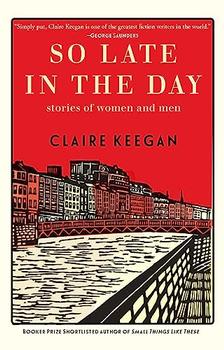Summary | Excerpt | Reviews | Beyond the Book | Read-Alikes | Genres & Themes | Author Bio

Stories of Women and Men
by Claire KeeganThis article relates to So Late in the Day
 Storytelling has always been an integral part of Irish heritage and culture. Originally, Irish stories were passed down through the generations by ear, first by bardic poets, and later by storytellers called seanchaí (or seanchaíwere, which means "bearer of old lore" in Gaelic). The bards and seanchaí weren't just storytellers; they were well-respected members of the community, responsible for preserving local history, genealogy, poetry, and myths of Ancient Ireland.
Storytelling has always been an integral part of Irish heritage and culture. Originally, Irish stories were passed down through the generations by ear, first by bardic poets, and later by storytellers called seanchaí (or seanchaíwere, which means "bearer of old lore" in Gaelic). The bards and seanchaí weren't just storytellers; they were well-respected members of the community, responsible for preserving local history, genealogy, poetry, and myths of Ancient Ireland.
The seanchaí were dedicated to their craft, living as vagabonds and practicing several arts at once. Essentially walking libraries, they were also dramatic entertainers, building scenes amidst fire smoke. The seanchaí told wondrous tales pulled from the four cycles of Early Irish literature, but quotidian stories as well. BBC explains: "While specialising in the swashbuckling myths of Cú Chulainn or Fionn mac Cumhaill, they also recorded and passed on local history, and – crucially for Ireland's rural communities – were a link to local goings on. It was the seanchaí's skill in making the everyday interesting that brought the Irish to blarney."
By the mid-1600s Gaelic Ireland was no more, and the seanchaí steadily began to fade into history. Irish magazines, journals, and newspapers of the 1830s assisted in making the shift in Irish storytelling from oral to written form.
Modern Irish short stories first garnered recognition in the early 20th century, with George Moore and James Joyce at the helm. Both explored the ordinary lives of the Irish. In Moore's 1903 collection The Untilled Field, there are references to traditional Gaelic folklore, with structure influenced by French and Russian writers. Joyce's most famous story collection, Dubliners (1914), details the struggles of peasants in Dublin, with links between stories made through symbolism and recurring characters.
From then on, realism was dominant. Frank O'Connor and Seán Ó Faoláin greatly advanced the modern Irish story with what Oxford Bibliographies calls the "psychology of human relations." Other mid-century writers that used realism to great effect include John McGahern, Mary Lavin, Seumas O'Kelly, Edna O'Brien, Daniel Corkery, and Maeve Binchy. Oxford Bibliographies further explains, "The short story came to be seen as the quintessential Irish literary form adapted to express the disillusionment of living in post-revolutionary Ireland dominated by social conservatism, literary censorship, and a puritanical religion."
Today, many writers still favor a straightforward approach, featuring the modest lives of their fellow Irish. Examples include Claire Keegan, with her newest collection So Late in the Day (2023), and Danielle McLaughlin's collection Dinosaurs on Other Planets (2015), which brings "a sharp new eye to stories about everyday life," according to LitHub.
Considering that Ireland has been historically inundated with hardship, it makes sense that the Irish story has been both an escape into epic sagas, and an inspection of commonplace joys and sorrows. Simple but with the depth of oceans, Ireland's short fiction continues to fascinate.
Filed under Places, Cultures & Identities
![]() This article relates to So Late in the Day.
It first ran in the January 10, 2024
issue of BookBrowse Recommends.
This article relates to So Late in the Day.
It first ran in the January 10, 2024
issue of BookBrowse Recommends.
Your guide toexceptional books
BookBrowse seeks out and recommends the best in contemporary fiction and nonfiction—books that not only engage and entertain but also deepen our understanding of ourselves and the world around us.